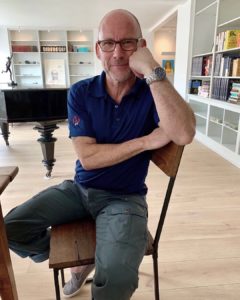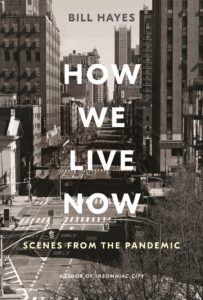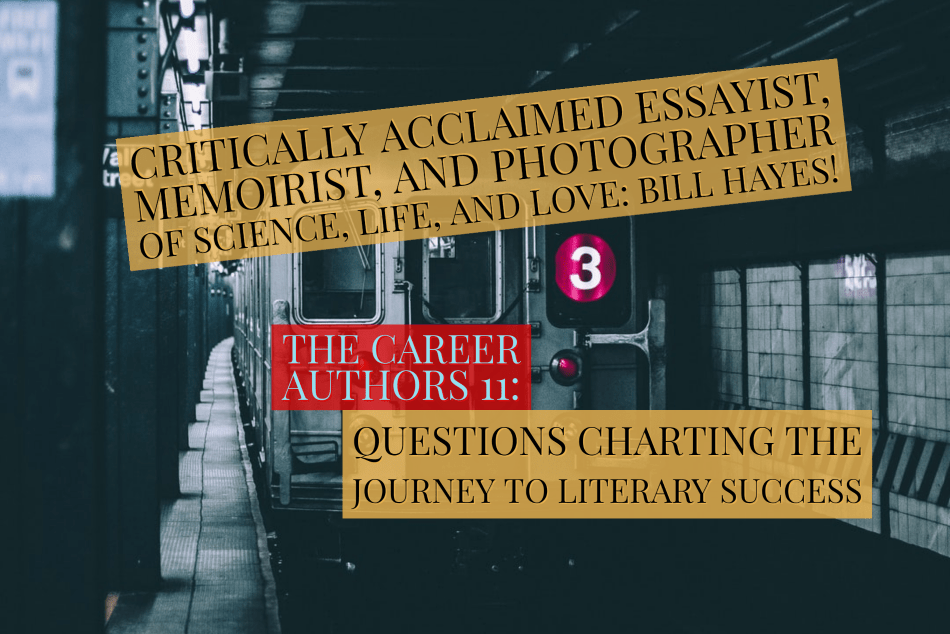Bill Hayes writes books that leave readers both awestruck and smarter. The title of his newest, How We Live Now: Scenes from a Pandemic, evokes Susan Sontag’s 1986 short story “The Way We Live Now,” which depicted the early days of the AIDS crisis. Bill’s essays and photography also chronicles culture as we live it. His work explores current topics from various angles; they may be visual or scientific, drawing from pop culture or matters of the heart.
All this makes us even more curious to hear how this renaissance man approaches some of the more practical aspects of writing and publishing.
1. What book changed your life?
Because I am both a writer and a photographer, I’d name two books: first, Joan Didion’s essay collection The White Album, which I read the year it was published, 1979, when I was 18; it opened a door I did not know existed, offering a model for the kind of prose I wanted to write. The long title essay was unlike anything I’d read before in its cumulative impact, but I also loved shorter pieces like “In Bed,” a personal essay about suffering migraine. In fact, I had that piece in mind when I later wrote an essay called “The Insomniac,” about my lifelong struggles with sleep. It ended up gettting plucked from a slush piled and published in the New York Times Magazine in 1996—my first major national publication—and it became the seed for my first book, Sleep Demons. The second life-changing book, one that had a huge influence on my interest in photography, was the Diane Arbus monograph from 1972, which I first stumbled upon when I was around 15 in a bookstore in Spokane, where I grew up. As with Didion’s prose, I felt at once that this was the sort of photgraphy I would want to practice. Yet it wasn’t until more than thirtyyears later that I actually bought a camera and began taking pictures after moving to New York.
2. Was your first published book the first manuscript you ever wrote?
Yes, that was Sleep Demons: An Insomniac’s Memoir. I don’t think anyone or thing—instructor, class, or book—can actually teach you how to write a book or how to write your book. You have to figure that out on your own.
3. Stephen King says, “The hardest part is just before you start.” What’s the hardest part of writing for you?
I no longer find writing “hard” (though I definitely did when I was younger). Which is not really the same as saying I find it easy or always enjoyable; it’s more like solving a challenging puzzle. I do often struggle with openings—and have to write multiple bad first drafts before I land on the right one. And I sometimes write past my endings. But this is where great editors come in, suggesting you try something differentt with an opening, or pointing out that it might be best to end a piece (or a book) one or two pages or paragraphs earlier.
4. Do you know the story’s ending before you start?
No, I almost never know the ending before I start. The only exception I can think of: I recently wrote the screenplay for a film adaptation of my memoir Insomniac City. I’d never written one before, and it was like learning a whole new skill, one that combined my experience with writing and photography. In this case, I did have an idea from the beginning about how the film should end—a different ending from the book. I knew it would work for film in a way that it wouldn’t have worked for the book.
5. When you’re having a difficult writing day, what do you tell yourself to get through it?
Something my first partner, Steve, used to tell me: “The only way out is through.” I still tell myself that some days.
6. Do you read your reviews?
Yes, most of them. I prefer when they’re positive, naturally. The only reviews I never read anymore—I’ve learned the hard way—are Goodread readers’ reviews. They can be rough!
7. Besides being persistent and correcting your spelling errors, what’s your best advice for a new author?
Listen to and trust your editor. Editors are vastly underappreciated and unrecognized in how they can shape and sharpen a piece of writing. I’ve been lucky to have the same editor on all six of my books, Nancy Miller. Of course, you must trust your gut, too—if you feel that you and your editor are not in agreement, you have to have that discussion. After all, it is your name that appears on the cover of a book or on the byline. I’ve had only one or two bad experiences with editors—always on magazine or newspaper pieces, which often have to be edited on the fly.
8. What’s your definition of writer misery?
I don’t think you can blame writing for your miseries. Reviews can make you miserable. Or social media comments can make you miserable. Or production issues with your book. Or a pressing deadline. But not writing itself.
9. What’s your definition of writer happiness?
Hearing from readers who’ve read something I’ve written—an essay, a book—and telling me what it meant to them.
10. What’s your favorite book on writing?
I don’t have one; I couldn’t even name one. On the other hand, I would never discourage aspiring writers to read such books—I’m sure there are wonderful ones—but they’ve never appealed to me. The same goes for photography. I love to go to exhibits and look through monographs, but I’ve never read a how-to book on photography or taken a class. As with writing, I’m pretty much self-taught.
11. What book are you reading right now?
I’m just finishing two books (The Equivalents, about Anne Sexton and others in her circle by Maggie Doherty, and White Rage by historian Carol Anderson), and I’m about to begin two more (What Becomes a Legend Most, a biography of Richard Avedon by Philip Gefter, and Stamped from the Beginning by Ibram X. Kendi). I’m usually reading a few books at once.

@Ron Zuckerman
 The recipient of a Guggenheim Fellowship in nonfiction, Bill Hayes is a frequent contributor to the New York Times and the author of five books: Sleep Demons; Five Quarts; The Anatomist; Insomniac City; and How We Live Now: Scenes from the Pandemic. His writing has also appeared in The Wall Street Journal, The New York Review of Books, the New York Times “T” Style Magazine, BuzzFeed, and The Guardian.
The recipient of a Guggenheim Fellowship in nonfiction, Bill Hayes is a frequent contributor to the New York Times and the author of five books: Sleep Demons; Five Quarts; The Anatomist; Insomniac City; and How We Live Now: Scenes from the Pandemic. His writing has also appeared in The Wall Street Journal, The New York Review of Books, the New York Times “T” Style Magazine, BuzzFeed, and The Guardian.
Hayes is also a photographer, with credits including The New Yorker, Vanity Fair, and the New York Times. His portraits of his partner, the late Oliver Sacks, appear in the volume of Dr. Sacks’s suite of final essays Gratitude. A collection of his street photography, How New York Breaks Your Heart, was recently published by Bloomsbury. His photographs have been exhibited at the Steven Kasher Gallery and at The Association of International Photography Art Dealers (AIPAD), New York City.
Hayes has lectured at NYU, UCSF, and University of Virginia, and has appeared at the Sydney Writers Festival, the 92nd Street Y, the Times of India (Mumbai) LitFest, and other venues. He serves as a co-editor of Dr. Sacks’ posthumously published work. Hayes, 59, lives in New York City.





